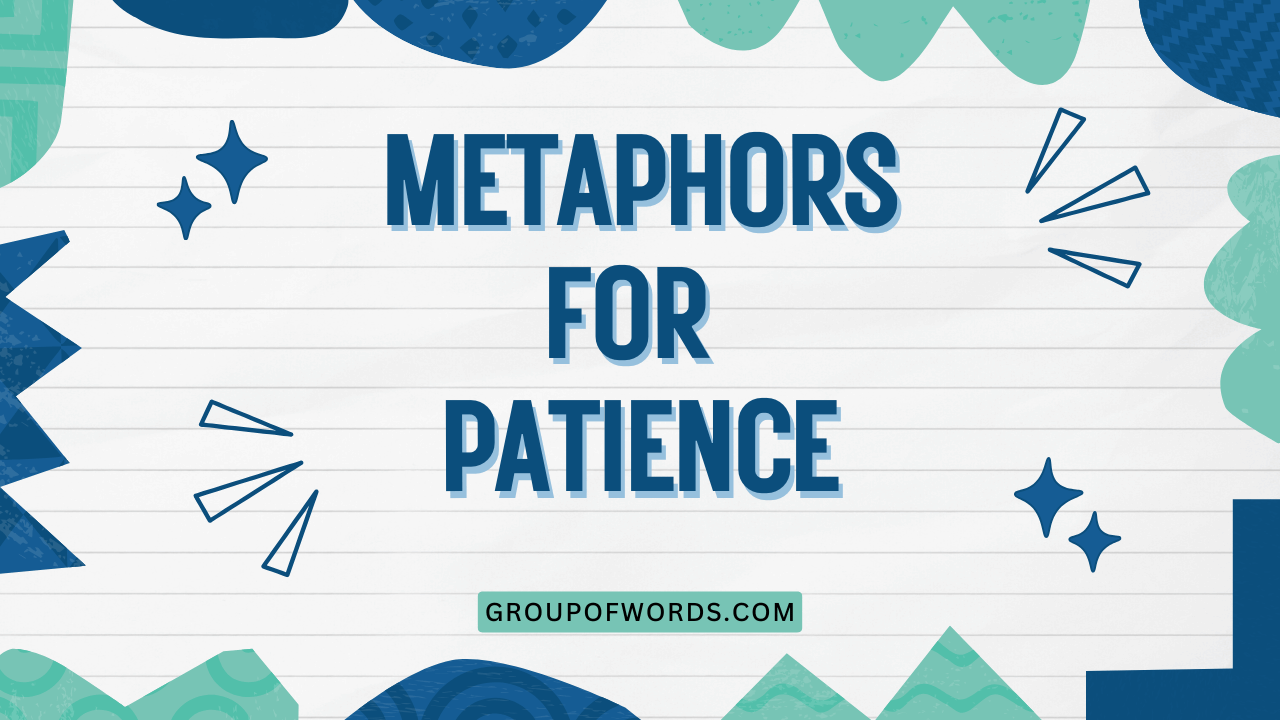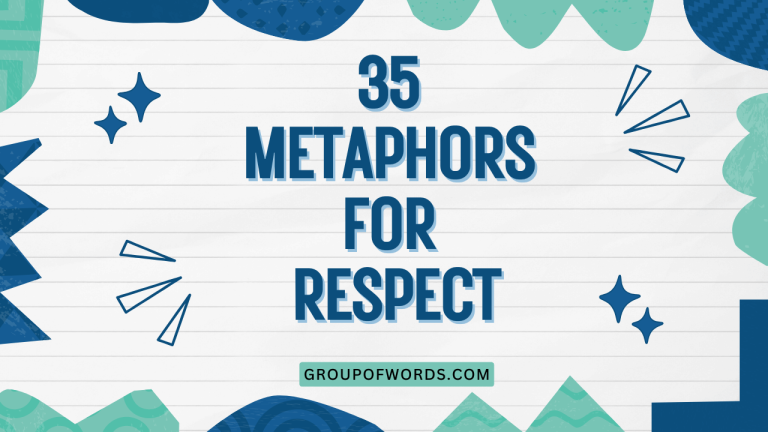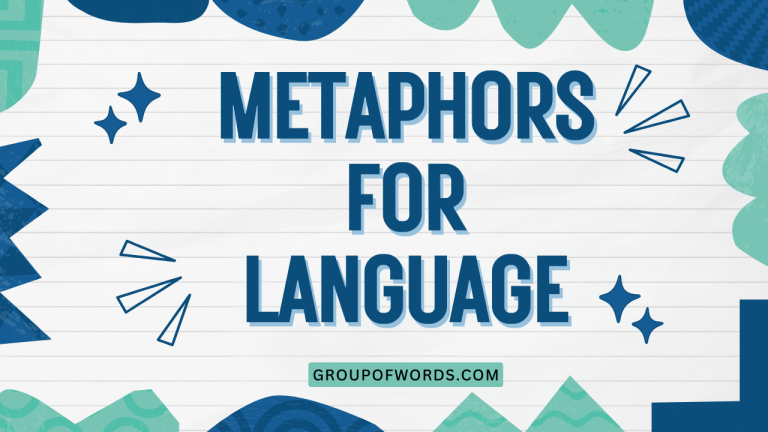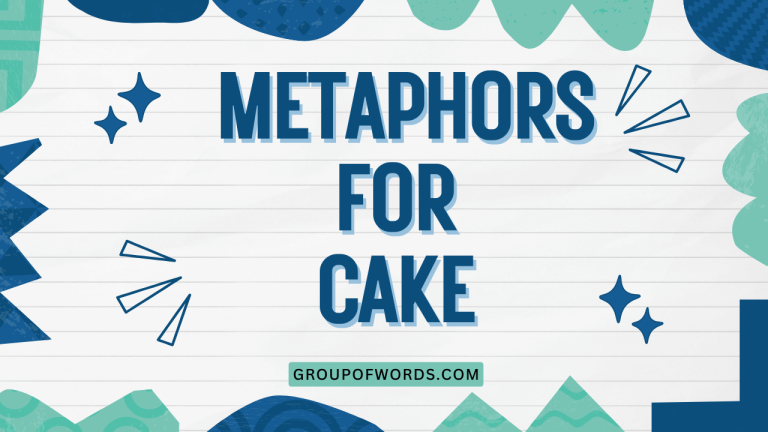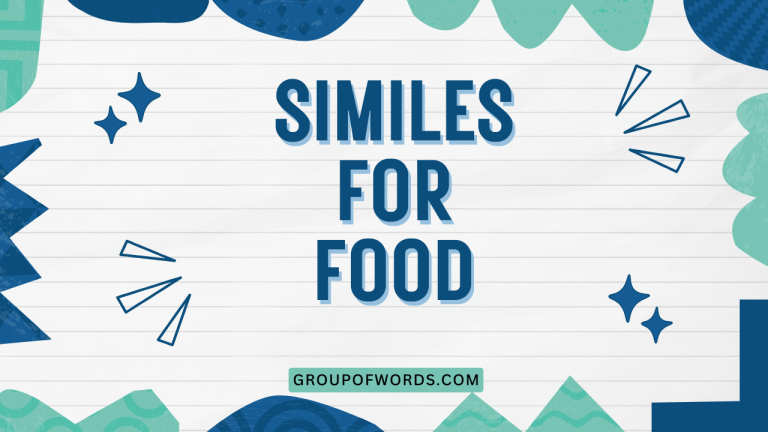Metaphors for Patience: A Comprehensive Guide
Patience, the capacity to accept or tolerate delay, trouble, or suffering without getting angry or upset, is a virtue often praised but not always easily practiced. To better understand and convey this complex emotion, we frequently turn to metaphors.
These figures of speech allow us to express the abstract concept of patience in more concrete and relatable terms. This article delves into the rich world of metaphors for patience, exploring their diverse forms, meanings, and applications in everyday language.
Whether you’re an English language learner, a seasoned writer seeking to enrich your prose, or simply someone interested in the nuances of language, this guide will provide you with a comprehensive understanding of patience metaphors.
Table of Contents
- Introduction
- Definition of Metaphor and Patience
- Structural Breakdown of Patience Metaphors
- Types of Metaphors for Patience
- Examples of Patience Metaphors
- Usage Rules for Patience Metaphors
- Common Mistakes with Patience Metaphors
- Practice Exercises
- Advanced Topics in Patience Metaphors
- Frequently Asked Questions
- Conclusion
Definition of Metaphor and Patience
What is a Metaphor?
A metaphor is a figure of speech that directly compares two unrelated things, asserting that one thing *is* another. Unlike similes, which use words like “like” or “as” to make a comparison, metaphors imply a resemblance or shared quality.
The purpose of a metaphor is to create a vivid image, evoke emotion, or offer a new perspective on a subject. Metaphors are essential tools in literature, poetry, and everyday language, enriching communication and adding layers of meaning.
For example, saying “He is a lion” is a metaphor, implying that he possesses the characteristics of a lion, such as courage and strength. This is different from saying “He is *like* a lion,” which is a simile.
The direct comparison in a metaphor makes it a powerful and concise way to convey meaning.
Defining Patience
Patience is the ability to endure hardship, delay, or provocation without becoming annoyed or upset. It’s a virtue that involves self-control and the capacity to remain calm and understanding in challenging situations.
Patience is often associated with qualities like tolerance, perseverance, and forgiveness. It is not simply about waiting; it’s about *how* one waits, maintaining a positive and composed attitude despite adversity.
Patience is crucial in many aspects of life, from personal relationships and professional endeavors to achieving long-term goals. Cultivating patience can lead to reduced stress, improved decision-making, and stronger interpersonal connections.
It’s a skill that requires conscious effort and practice, as it goes against our natural inclination to seek immediate gratification.
Structural Breakdown of Patience Metaphors
Patience metaphors typically work by associating the abstract concept of patience with a more concrete and understandable image or process. This often involves two key elements: the **tenor** and the **vehicle**.
The tenor is the subject being described (in this case, patience), and the vehicle is the image or concept used to represent it. The effectiveness of a patience metaphor depends on the degree to which the vehicle effectively captures the essence of patience.
For instance, in the metaphor “Patience is a virtue,” patience is the tenor, and “a virtue” is the vehicle. The metaphor works because virtues are generally understood to require cultivation and restraint, qualities also associated with patience.
The structural breakdown helps us understand how the metaphor functions to create meaning and impact. Identifying the tenor and vehicle is the first step in analyzing and appreciating the richness of metaphorical language.
Furthermore, the context in which a metaphor is used plays a vital role in its interpretation. The surrounding words, the speaker’s intention, and the audience’s background knowledge all contribute to how the metaphor is understood.
A metaphor that resonates in one context might be confusing or ineffective in another. Therefore, careful consideration of the context is essential when using and interpreting patience metaphors.
Types of Metaphors for Patience
Patience metaphors can be categorized based on the specific images or concepts they draw upon. Here are some common types:
Nature-Based Metaphors
Nature-based metaphors often compare patience to natural processes like growth, seasons, or the slow but steady erosion of rock. These metaphors highlight the idea that patience involves waiting for things to unfold in their own time, just as nature follows its own rhythms.
The natural world provides a wealth of imagery that lends itself well to illustrating the concept of patience.
Examples include: “Patience is the slow growth of a tree,” “Patience is the changing of seasons,” and “Patience is the steady drip that wears away the stone.” These metaphors emphasize the gradual and persistent nature of patience, drawing parallels to the unhurried pace of the natural world.
Journey-Related Metaphors
Journey-related metaphors depict patience as a long and arduous journey, requiring perseverance and endurance. These metaphors often focus on the challenges encountered along the way and the importance of staying focused on the destination.
The analogy of a journey effectively captures the idea that patience is not passive waiting but an active process of moving forward despite obstacles.
Examples include: “Patience is a long road,” “Patience is climbing a mountain,” and “Patience is navigating a maze.” These metaphors emphasize the effort and determination required to maintain patience in the face of adversity, framing it as an active pursuit rather than a passive state.
Growth and Development Metaphors
Growth and development metaphors equate patience with the process of nurturing and cultivating something over time. These metaphors highlight the idea that patience involves providing the necessary conditions for growth and then allowing it to unfold naturally.
The imagery of planting seeds and tending to them until they blossom is particularly effective in illustrating this type of patience.
Examples include: “Patience is planting a seed and waiting for it to grow,” “Patience is nurturing a plant,” and “Patience is cultivating a skill.” These metaphors emphasize the active role of patience in fostering growth and development, highlighting the importance of care and attention.
Material and Construction Metaphors
Material and construction metaphors compare patience to the process of building or crafting something, emphasizing the need for careful planning, attention to detail, and a willingness to start over when necessary. These metaphors often focus on the idea that patience involves taking a methodical approach and working steadily towards a desired outcome.
Examples include: “Patience is building a house brick by brick,” “Patience is crafting a sculpture,” and “Patience is weaving a tapestry.” These metaphors emphasize the deliberate and incremental nature of patience, highlighting the importance of precision and perseverance in achieving a desired result.
Weather-Related Metaphors
Weather-related metaphors use weather phenomena to describe patience, often highlighting its ability to weather storms, endure difficult periods, and eventually emerge into calmer conditions. These metaphors emphasize the resilience and adaptability required to maintain patience in the face of challenges.
Examples include: “Patience is weathering the storm,” “Patience is waiting for the rain to stop,” and “Patience is the calm after the storm.” These metaphors emphasize the cyclical nature of challenges and the importance of enduring difficult times with the understanding that they will eventually pass.
Examples of Patience Metaphors
The following tables provide extensive examples of patience metaphors, organized by category:
Nature-Based Examples
This table showcases metaphors that draw upon natural processes to illustrate the concept of patience.
| Metaphor | Explanation |
|---|---|
| Patience is the slow growth of a tree. | Like a tree that takes years to mature, patience requires time and steady growth. |
| Patience is the changing of seasons. | Just as seasons change gradually, patience involves accepting the natural progression of events. |
| Patience is the steady drip that wears away the stone. | Persistence and consistency, like a dripping faucet, can overcome even the most challenging obstacles. |
| Patience is the blooming of a flower. | Like a flower that takes time to blossom, patience allows things to unfold in their own time. |
| Patience is the flow of a river. | Patience is like a river, constantly moving forward, adapting to obstacles, and eventually reaching its destination. |
| Patience is the quiet strength of the mountains. | Mountains stand tall and unwavering, symbolizing the steadfastness of patience. |
| Patience is the patient spider building its web. | The spider meticulously constructs its web, illustrating the need for careful planning and execution. |
| Patience is the farmer waiting for the harvest. | The farmer patiently waits for the crops to ripen, understanding that premature action will be detrimental. |
| Patience is the earth absorbing the rain. | The earth absorbs the rain, nourishing life and symbolizing the ability to endure hardship. |
| Patience is the tide slowly coming in. | The tide gradually rises, illustrating the slow and steady progress of patience. |
| Patience is the gradual formation of a pearl. | The pearl’s beauty takes time to develop, much like the rewards of patience. |
| Patience is the long wait for the sun to rise. | Even in darkness, the sun will eventually rise, symbolizing hope and the eventual reward of patience. |
| Patience is the turtle’s slow and steady pace. | The turtle may be slow, but it consistently moves forward, embodying the persistence of patience. |
| Patience is the ant diligently carrying its load. | The ant’s unwavering effort symbolizes the dedication required for patience. |
| Patience is the forest silently growing. | The forest’s quiet growth exemplifies the unseen progress of patience. |
| Patience is the seed patiently waiting to sprout. | The seed’s dormant period represents the necessary waiting period in patience. |
| Patience is the moth emerging from its cocoon. | The transformation from cocoon to moth symbolizes the positive outcomes of patience. |
| Patience is the slow, steady erosion of the canyon walls. | The canyon’s formation over time highlights the powerful effect of consistent effort. |
| Patience is the long lifespan of the ancient redwood. | The redwood’s longevity symbolizes the enduring nature of patience. |
| Patience is the quiet stillness of a deep lake. | The lake’s tranquility represents the calm and composed nature of patience. |
| Patience is the process of a caterpillar becoming a butterfly. | This elaborate metamorphosis demonstrates that patience brings beautiful transformation. |
| Patience is the unhurried pace of a snail crossing a leaf. | The snail’s slow movement emphasizes the importance of steady progress, even if it seems insignificant. |
| Patience is the steadfastness of a lighthouse guiding ships through the night. | The lighthouse symbolizes unwavering support and guidance, mirroring the support patience provides. |
Journey-Related Examples
This table provides metaphors that compare patience to different types of journeys.
| Metaphor | Explanation |
|---|---|
| Patience is a long road. | Like a long road, patience requires endurance and a willingness to keep going despite challenges. |
| Patience is climbing a mountain. | Climbing a mountain demands perseverance and the ability to overcome obstacles, just like patience. |
| Patience is navigating a maze. | Navigating a maze requires careful planning and the ability to adapt to unexpected turns, mirroring the challenges of patience. |
| Patience is sailing a ship through a storm. | Sailing through a storm demands resilience and the ability to weather difficult conditions, just like patience. |
| Patience is running a marathon. | Running a marathon requires stamina and the ability to pace oneself, mirroring the need for self-control in patience. |
| Patience is trekking through a dense forest. | Navigating a dense forest requires careful navigation and a willingness to persevere through difficult terrain. |
| Patience is crossing a desert. | Crossing a desert requires resilience and the ability to endure harsh conditions. |
| Patience is rowing a boat upstream. | Rowing upstream demands strength and determination to overcome resistance. |
| Patience is a pilgrimage to a sacred place. | A pilgrimage requires dedication and commitment to a meaningful goal. |
| Patience is a long and winding river. | A winding river requires adaptability and the ability to navigate unexpected turns. |
| Patience is a slow train journey. | A slow train journey requires acceptance of delays and the ability to enjoy the scenery along the way. |
| Patience is a long walk home in the rain. | Walking home in the rain requires resilience and the ability to endure discomfort. |
| Patience is a difficult puzzle to solve. | Solving a difficult puzzle requires persistence and the ability to try different approaches. |
| Patience is a treasure hunt with many false leads. | A treasure hunt requires perseverance and the ability to follow clues despite setbacks. |
| Patience is a quest for knowledge. | A quest for knowledge requires dedication and a willingness to learn from mistakes. |
| Patience is a journey of self-discovery. | A journey of self-discovery requires introspection and a willingness to confront one’s own flaws. |
| Patience is a tightrope walk. | Walking a tightrope requires balance and focus to avoid falling. |
| Patience is a dance that takes time to learn. | Mastering a dance requires practice and the ability to learn from mistakes. |
| Patience is a crossword puzzle with challenging clues. | Crossword puzzles require persistence in finding answers, even when clues are difficult. |
| Patience is a scavenger hunt leading to a hidden prize. | Scavenger hunts demand perseverance in finding clues, even when the search takes time. |
| Patience is a hike to the summit of a distant mountain. | Hiking to a summit requires long-term dedication and endurance, representing the rewards of patience. |
| Patience is like learning to ride a bicycle, requiring practice and acceptance of falls. | Learning to ride a bike involves repeated attempts and accepting setbacks as part of the process. |
| Patience is the arduous task of building a sandcastle against the incoming tide. | Building a sandcastle against the tide shows the need for constant effort and acceptance of possible loss. |
Growth and Development Examples
This table showcases metaphors that relate patience to growth and development.
| Metaphor | Explanation |
|---|---|
| Patience is planting a seed and waiting for it to grow. | Like a seed that requires time and care to germinate, patience involves nurturing something over time. |
| Patience is nurturing a plant. | Nurturing a plant requires providing the right conditions for growth and allowing it to unfold naturally, just like patience. |
| Patience is cultivating a skill. | Cultivating a skill requires practice and dedication over time, mirroring the effort involved in patience. |
| Patience is learning a new language. | Learning a new language requires consistent effort and the acceptance of mistakes along the way. |
| Patience is developing a close friendship. | Developing a close friendship requires time and nurturing, similar to the process of patience. |
| Patience is the slow maturation of wine. | Wine requires time to mature and develop its full flavor. |
| Patience is the careful molding of clay. | Clay requires gentle shaping to achieve the desired form. |
| Patience is the gradual healing of a wound. | A wound requires time and care to heal properly. |
| Patience is the slow accumulation of knowledge. | Knowledge is gained gradually through consistent learning. |
| Patience is the steady growth of a business. | A business requires time and effort to grow and thrive. |
| Patience is the slow cooking of a stew. | Stew requires time to simmer and develop its full flavor. |
| Patience is the careful training of an athlete. | An athlete requires time and dedication to reach their full potential. |
| Patience is the gradual mastery of a musical instrument. | Mastering a musical instrument requires practice and dedication. |
| Patience is the slow development of a photograph. | A photograph requires time to develop and reveal its image. |
| Patience is the hatching of an egg. | An egg requires time to incubate and hatch. |
| Patience is the careful editing of a manuscript. | A manuscript requires careful revision to achieve its final form. |
| Patience is the slow aging of cheese. | Cheese requires time to mature and develop its full flavor. |
| Patience is the gradual evolution of an idea. | An idea requires time to develop and refine. |
| Patience is the careful process of brewing a perfect cup of tea. | Tea requires time to steep properly, just like patience in various situations. |
| Patience is the artistic development of a painter perfecting their masterpiece. | A painter needs ample time to realize their vision on canvas, an example of the value of time. |
| Patience is the careful preparation of a bonsai tree over many years. | Bonsai trees require years of diligent care and trimming, a metaphor for long-term patience. |
| Patience is like the slow and steady progress of a child learning to walk. | Learning to walk involves numerous attempts and gradual improvement, mirroring the process of developing patience. |
| Patience is the process of learning calligraphy, where each stroke requires precision and control. | Calligraphy requires meticulous practice and attention to detail, emphasizing the value of deliberate action. |
Material and Construction Examples
This table presents metaphors that compare patience to building or crafting something.
| Metaphor | Explanation |
|---|---|
| Patience is building a house brick by brick. | Like building a house, patience requires a step-by-step approach and steady progress. |
| Patience is crafting a sculpture. | Crafting a sculpture demands careful attention to detail and a willingness to refine one’s work, similar to patience. |
| Patience is weaving a tapestry. | Weaving a tapestry requires intricate work and the ability to see the bigger picture, mirroring the complexities of patience. |
| Patience is assembling a complex machine. | Assembling a machine requires careful planning and the ability to follow instructions, just like patience. |
| Patience is knitting a sweater stitch by stitch. | Knitting a sweater requires repetitive work and the ability to focus on the task at hand, similar to patience. |
| Patience is carefully piecing together a mosaic. | A mosaic requires careful placement of each piece to create a beautiful design. |
| Patience is slowly constructing a bridge. | Building a bridge requires meticulous planning and execution. |
| Patience is meticulously restoring an antique. | Restoring an antique requires careful attention to detail and a respect for the past. |
| Patience is painstakingly writing a novel. | Writing a novel requires dedication and perseverance over a long period of time. |
| Patience is carefully assembling a jigsaw puzzle. | A jigsaw puzzle requires careful observation and problem-solving skills. |
| Patience is slowly building a sandcastle. | Building a sandcastle requires careful planning and execution. |
| Patience is meticulously crafting a piece of jewelry. | Crafting jewelry requires precision and attention to detail. |
| Patience is carefully constructing a model airplane. | Building a model airplane requires patience and attention to detail. |
| Patience is slowly building a fire. | Building a fire requires careful attention to the elements. |
| Patience is meticulously creating a work of art. | Creating art requires patience and attention to detail. |
| Patience is carefully constructing a house of cards. | Building a house of cards requires balance and precision. |
| Patience is slowly carving a statue from stone. | Carving a statue requires precision and attention to detail. |
| Patience is meticulously designing a quilt. | Designing a quilt requires careful planning and creativity. |
| Patience is like assembling a ship in a bottle, requiring meticulous attention. | Building a ship in a bottle needs extreme precision and calm hands. |
| Patience is constructing a delicate origami figure, where each fold matters. | Origami requires careful folds and calm to prevent tearing the paper. |
| Patience is crafting a stained-glass window, with each piece carefully placed. | Creating a stained-glass window requires precise cuts and careful arrangement. |
| Patience is akin to the detailed work involved in creating a complex clock mechanism. | Clock mechanisms require precision and patience, mirroring the virtue in various facets of life. |
| Patience mirrors the careful restoration of a vintage car, requiring time and attention. | Restoring a vintage car needs meticulous work and a deep respect for its history. |
Weather-Related Examples
This table lists metaphors that use weather phenomena to describe patience.
| Metaphor | Explanation |
|---|---|
| Patience is weathering the storm. | Like enduring a storm, patience involves enduring difficult times with resilience. |
| Patience is waiting for the rain to stop. | Waiting for the rain to stop requires accepting the present conditions and knowing they will eventually pass. |
| Patience is the calm after the storm. | The calm after the storm represents the peace and tranquility that come after enduring difficult times, a reward for patience. |
| Patience is the sunshine after the rain. | Sunshine after the rain symbolizes hope and the brighter days that come after enduring challenges, mirroring the result of patience. |
| Patience is the gentle breeze that follows a hurricane. | A gentle breeze provides relief after a destructive hurricane, showing the positive impact of patience. |
| Patience is the fog slowly lifting. | Fog lifts gradually, revealing clarity and visibility. |
| Patience is the snow melting in the spring. | Snow melts slowly, transforming the landscape. |
| Patience is the slow clearing of the clouds. | Clouds clear gradually, revealing the blue sky. |
| Patience is the steady fall of snow. | Snow falls steadily, covering the landscape. |
| Patience is the gentle patter of rain. | Rain falls gently, nourishing the earth. |
| Patience is the warmth of the sun after a cold winter. | Sun brings warmth and relief after a long winter. |
| Patience is the rainbow after the storm. | Rainbows symbolize hope and promise after difficult times. |
| Patience is the steady rhythm of the tides. | Tides rise and fall predictably, representing reliability. |
| Patience is the quiet stillness before a snowfall. | Stillness creates a sense of anticipation and calm. |
| Patience is the gentle dew on a summer morning. | Dew refreshes and rejuvenates the landscape. |
| Patience is the soft glow of twilight. | Twilight provides a gentle transition from day to night. |
| Patience is like waiting out a blizzard, knowing that eventually, the sun will shine again. | Blizzards are tough, but you know that with patience, the sun will shine again. |
| Patience is the serene calm of a cloudless sky, a reward after turbulent weather. | After a storm, a sky with no clouds represents the peacefulness of patience. |
| Patience is akin to waiting for the monsoon season to end, knowing relief is on the way. | Monsoon seasons end, and relief is on the way. |
| Patience is like the fog rolling in, obscuring the view but eventually passing. | Fog will roll in, but it will eventually pass. |
| Patience is comparable to waiting for the ice to thaw in winter, knowing warmer days are coming. | Ice will thaw in winter, and warmer days are coming. |
| Patience is similar to enduring a heatwave, trusting cooler temperatures will return. | Trust cooler temperatures will return. |
Usage Rules for Patience Metaphors
When using metaphors for patience, it’s crucial to ensure clarity and relevance. The metaphor should resonate with the audience and effectively convey the intended meaning.
Avoid using clichés or overused metaphors, as they can lose their impact. Instead, strive for originality and creativity in your metaphorical language.
The key is to choose a vehicle that accurately reflects the essence of patience and enhances the reader’s understanding.
Another important consideration is the context in which the metaphor is used. The surrounding words and the overall tone of the writing should support the metaphor and contribute to its effectiveness.
A well-chosen metaphor can add depth and richness to your writing, but a poorly chosen one can be confusing or distracting. Therefore, careful selection and thoughtful application are essential for using patience metaphors effectively.
Furthermore, be mindful of the cultural connotations associated with different metaphors. A metaphor that resonates in one culture might be misinterpreted or misunderstood in another.
For example, certain animals or natural phenomena may have different symbolic meanings in different cultures. Therefore, it’s important to be sensitive to cultural differences when using metaphors for patience, especially when communicating with a diverse audience.
Common Mistakes with Patience Metaphors
One common mistake is using mixed metaphors, where the tenor is compared to multiple vehicles that are inconsistent or contradictory. For example, saying “Patience is a long road that blooms like a flower” combines a journey metaphor with a growth metaphor in a way that doesn’t quite make sense.
It’s important to maintain consistency in your metaphorical language to avoid confusion.
Another common mistake is using metaphors that are too abstract or obscure. The vehicle should be something that the audience can easily relate to and understand.
If the metaphor is too far-fetched or requires specialized knowledge, it may not effectively convey the intended meaning. Clarity and accessibility are key to using metaphors effectively.
Finally, avoid using metaphors that are overly sentimental or melodramatic. Patience is a virtue that involves strength and resilience, not weakness or despair.
Therefore, your metaphors should reflect these qualities and avoid portraying patience as something passive or self-pitying. The goal is to inspire and encourage, not to evoke feelings of sadness or helplessness.
| Incorrect | Correct | Explanation |
|---|---|---|
| Patience is a volcano waiting to erupt, but it’s also a gentle stream. | Patience is a gentle stream that flows steadily. | Mixed metaphors create confusion. Stick to a single, consistent image. |
| Patience is like the fourth dimension. | Patience is like waiting for a seed to sprout. | Abstract metaphors are difficult to grasp. Use relatable images. |
| Patience is a bottomless pit of despair. | Patience is a strong bridge that carries us over troubled waters. | Avoid negative or melodramatic metaphors. Focus on strength and resilience. |
| Patience is a unicorn riding a rainbow. | Patience is the steady climb of a determined mountaineer. | Avoid fantastical or unrealistic metaphors. Use practical and relatable images. |
| Patience is as complex as quantum physics. | Patience is as simple as waiting for bread to rise. | Avoid overcomplicated metaphors. Simplicity enhances understanding. |
Practice Exercises
Test your understanding of patience metaphors with the following exercises:
Exercise 1: Identify the Type of Metaphor
Identify the type of metaphor used in each of the following sentences (Nature, Journey, Growth, Material, Weather):
- Patience is the steady drip that wears away the stone.
- Patience is climbing a mountain.
- Patience is planting a seed and waiting for it to grow.
- Patience is building a house brick by brick.
- Patience is weathering the storm.
- Patience is a long road.
- Patience is nurturing a plant.
- Patience is crafting a sculpture.
- Patience is the sunshine after the rain.
- Patience is the slow growth of a tree.
Answer Key:
- Nature
- Journey
- Growth
- Material
- Weather
- Journey
- Growth
- Material
- Weather
- Nature
Exercise 2: Complete the Metaphor
Complete the following metaphors with an appropriate ending:
- Patience is like __________.
- Patience is a __________.
- Patience is as __________ as __________.
- Patience is the art of __________.
- Patience is the key to __________.
- Patience is a virtue that __________.
- Patience is the opposite of __________.
- Patience is essential for __________.
- Patience is often rewarded with __________.
- Patience is a skill that __________.
Sample Answers:
- Patience is like a marathon, requiring endurance and perseverance.
- Patience is a long journey with many unexpected turns.
- Patience is as strong as the roots of an ancient tree.
- Patience is the art of waiting without losing hope.
- Patience is the key to unlocking success.
- Patience is a virtue that allows us to overcome challenges.
- Patience is the opposite of impulsiveness.
- Patience is essential for building strong relationships.
- Patience is often rewarded with inner peace.
- Patience is a skill that can be cultivated through practice.
